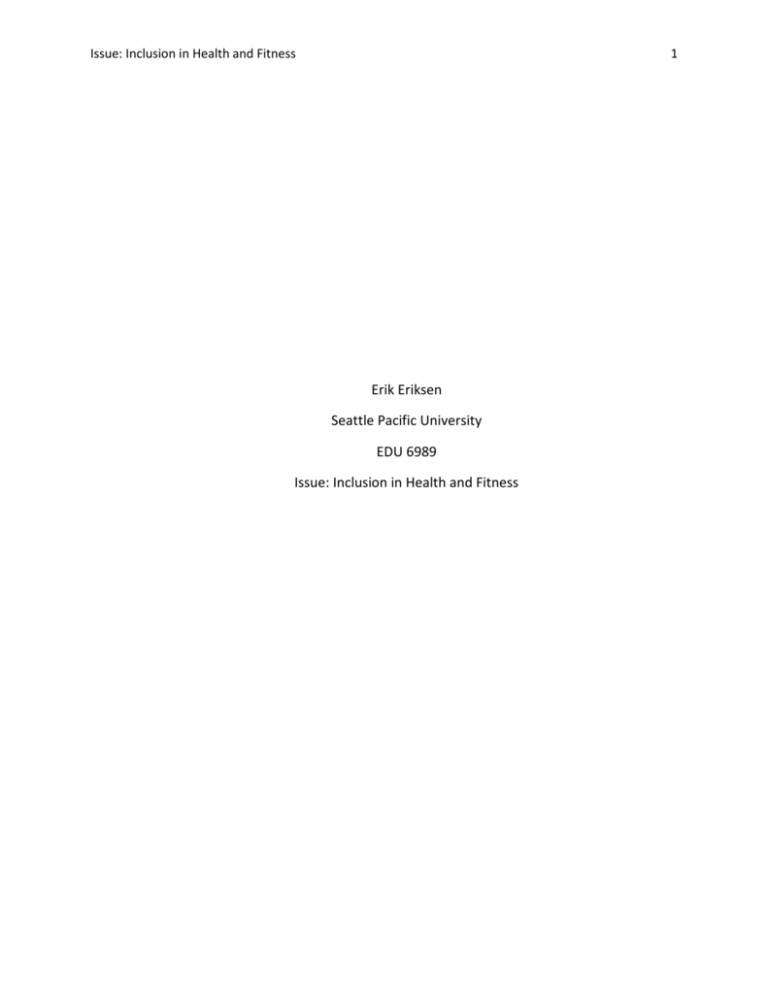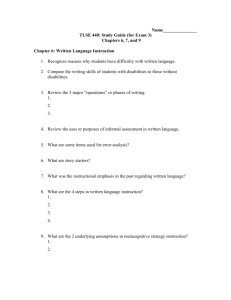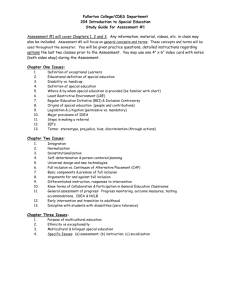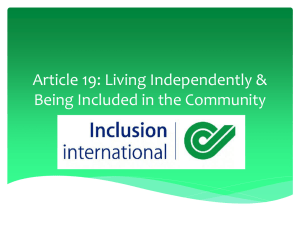E.Eriksen.Issue
advertisement

Issue: Inclusion in Health and Fitness 1 Erik Eriksen Seattle Pacific University EDU 6989 Issue: Inclusion in Health and Fitness Issue: Inclusion in Health and Fitness 2 Within the field of education, inclusion is undoubtedly an issue of great debate. Though, it seems as of late, that the debate has shifted from whether or not to include students with disabilities in general education classes, but rather how to include students with disabilities while maintaining the greatest possible education. This shift is apparent in the core subjects and also, as will be outlined, subjects such as Health and Fitness. While the benefits of inclusion are clear, the requirements for including students with disabilities in general education classes may worry many educators. “Inclusion requires more than simply placing the child with a disability in the general education class; one must provide the necessary supports according to the child’s needs for an adequate educational experience.” (Cervantes, Lieberman, Magnesio & Wood, 2013, pg. 43) In an ideal environment, all teachers would be properly trained to confidently educate special education students and would also be provided a qualified para-educator. Unfortunately for both students and educators, there are many instances where the teacher is neither properly prepared nor provided with a paraeducator that they feel is qualified. The services of para-educators can potentially provide teachers and students with more individual attention. “Yet paraprofessionals are typically the least qualified, least respected, and the lowest paid of the teaching staff, yet they are often expected to support and provide instruction to the most challenging SwD.” (Pederssen, Cooley, Rottier, 2014, pg. 3) (SwD meaning Student with Disabilities) Hiring of para-educators rarely requires experience in education and is typically left up to a school’s principal, leaving the teachers without a say in who will eventually be expected to help provide their students a quality education. While these Issue: Inclusion in Health and Fitness 3 qualifications, or lack of qualification in some cases, may not directly lead to poor performance by a para-educator, many educators still do not feel entirely comfortable with their ability to provide quality assistance when it is needed. In one study, participants (Physical Education teachers who took part in the study) expressed confidence in their para-educators when it came to aspects such as making the classroom a safe place, helping create an “enjoyable” classroom environment, and being able to control situations involving disruptive behavior. Though, participants in this study had much lower confidence in the para-educator’s ability to connect with students, promote a learning environment, and motivate students to perform the task at hand. While a general-education environment for a student with disabilities that is safe, enjoyable, and has support for disruptive behavior is largely important to inclusion, the educational goals of inclusion call for more support in the way of connecting with, promoting learning for, and motivating students. (Pederssen, Cooley, Rottier, 2014, pg. 6) Though many educators have concerns about the ability of their para-educators, some believe these concerns are rooted also in the lack of belief in the teacher’s own ability to provide a quality education in an inclusive classroom environment. In the previously mentioned study, one educator spoke about their concerns, “Without the paraprofessional in attendance general students would be adversely affected in a group situation, no matter how patient and kind they are. Without a paraprofessional present, someone must miss out on teacher time, the child with the disability or the class.” (Pederssen, Cooley, Rottier, 2014, pg. 7) Concerns such as this speak equally to the need of qualified para-educators and also the need to properly Issue: Inclusion in Health and Fitness 4 prepare the educators to be able to provide a quality education to an inclusive classroom. Without proper preparation, educators are likely to feel overwhelmed or helpless regardless of the presence of a qualified para-educator. The article Pre-Service Physical Education Teachers and Inclusive Education: Attitudes, Concerns, and Perceived Skills provides that “the attitude of the teacher can have a direct influence on the successful inclusion of students with disabilities into regular classes.” (Mangope, Mannathoko, Kuyini, 2013) Some educators approached teaching students with disabilities with more confidence than many of their contemporaries. Teachers who taught students of younger grade levels generally had more positive feelings, as well as those who worked with students with less severe disabilities. Teachers’ attitudes were also heavily influenced by previous experience working with students with disabilities as well as the level of education they had received prior to working with students with disabilities. (Mangope et al., 2013) The study described in the article was performed to determine what many pre-teachers were concerned about and how capable they felt they were of working with students with disabilities. The most common concerns, of the eighty-six pre-teachers surveyed, were in regards to their skills as a teacher, the pressure of time constraints, available resources for inclusive education, and being able provide adequate education to students with and without disabilities. With concerns such as those, it is no surprise many teachers enter the workplace with uncertainty of their ability to perform in an inclusive environment, no matter how they feel about the students themselves. Issue: Inclusion in Health and Fitness 5 Overall, the pre-teachers in the study held positive feelings toward working with students with disabilities, though the positive numbers were skewed toward students who were “shy and withdrawn” and less so toward students with more severe disabilities. Unfortunately these pre-teachers are facing these concerns before having even worked a full year in a school or with in a classroom requiring an inclusive approach. Fortunately, though, there is still time for these pre-teachers to share their concerns and encourage their professors to provide them with further preparation. In schools around the globe, there is a fear of being able to provide an adequate education to students with disabilities in an inclusive classroom without failing to challenge the general education students. Proper preparation in teacher education programs will provide teachers who are confident and capable of providing a quality education to all students they serve. (Mangope et al., 2013) An article from Journal of Physical Education, Recreation, and Dance (Braga, Tracy, Taliaferro, 2015) suggests that Health and Fitness educators use Newell’s model of constraints to better understand the needs of the students they teach. Newell’s model is based on understanding the individual, the environment that the student is in, and the tasks that the student in being asked to complete. “Understanding individual constraints and how they interact with the environment and the task is critical for designing appropriate activities leading to learning and enjoyment of various types of PA.” (Braga, Tracy, Taliaferro, 2015, pg. 17) (PA meaning Physical Activity) Using Newell’s model of constraints will aide educators in viewing the relationship between the three constraints as a dynamic relationship and that all three have a heavy influence on the successful inclusion of a student with disabilities into a general education class. Issue: Inclusion in Health and Fitness 6 Because many Health and Fitness classes involve the playing of various popular sports, it is important for educators to develop modifications that both allow the students to fully participate and succeed in the task, but also to find modifications that “do not alter the nature of the game.” (Braga, Tracy, Taliaferro, 2015, pg. 19) An example of both a positive modification and a negative modification in a soccer unit would be making the goals larger or smaller versus making the goal of the activity to kick a soccer ball as far as the student is able to. The first modification allows the nature of Soccer to remain, while the second modification removes the need for accuracy and team play, among other aspects. With well-designed lessons and modifications, an educator will be able to use similar modifications for sports and activities that are based on similar strategies and skills. Because some physical activities “are based on similar skills, concepts, and strategies, they also have similar environmental and task constraints.” (Braga, Tracy, Taliaferro, 2015, pg. 22) Over time, educators will have several go-to modifications that can be used on a variety of tasks to create a more supportive environment for students with disabilities without removing aspects of activities that will also benefit general-education students. While also being conveniently named, the inclusion style of teaching mentioned in European Physical Education Review, is an ideal educational approach for educators who are aiming to provide a differentiated, quality education where the students are not only active, but also acquire knowledge and skills appropriate to their current abilities. (Byra, Sanchez, Wallhead, 2014) Issue: Inclusion in Health and Fitness 7 A style of teaching that is common in many Health and Fitness classes is often called the “command style”. (Byra, Sanchez, Wallhead, 2014, pg. 15) This style involves the educator choosing a general skill for the entire class to learn. In this style, the teacher will tell the students what to do, demonstrate the skills, and then observe the entire class as they practice the skill. Feedback often comes at the end of the lesson and is directed to the general performance of the entire class. The inclusion style, however, involves the educator demonstrating various levels of a particular skill (simple to complicated) and providing the students the choice of which level to start at. Because there are various levels of a skill available for a student to attempt, students of all capabilities will be able to challenge themselves while also being able to find a level of the skill that they are comfortable attempting. It is important to note that the goal of the inclusion style is not to simply maximize the amount of time that students are active, but is “more about engaging at an appropriate skill/task level.” (Byra, Sanchez, Wallhead, 2014, pg. 16) During this time, since the activity is primarily self-led, the educator is able to roam the classroom and provide immediate, individualized feedback. Individualized feedback that is vital for all students, especially students with learning disabilities, and with a para-educator present, the quality of education will be high. (Byra, Sanchez, Wallhead, 2014) Another tactic that educators have been employing to assist with inclusion is peertutoring. Peer-tutoring, as the name suggests, involves students assisting other students. While peer-tutoring is often thought of as a student with disabilities being tutored by a student Issue: Inclusion in Health and Fitness 8 without disabilities, there are a variety of techniques that educators can use in order to best fit their curriculum and other requirements. In the article Peer Tutoring: Meeting the Demands of Inclusion in Physical Education Today, various peer-tutoring techniques are listed: Unidirectional (one-on-one, student without disability tutors student with disability), Reciprocal (one or more-on-one or more, students with disabilities and students without disabilities tutor each other), Cross-Age (one-on-one, older student without disabilities tutors student with disabilities), Class-Wide (small groups, students with disabilities and students without disabilities tutor each other as they progress through activities). It is suggested that a selection, or even all, of these approaches be used throughout a year in order to provide the best possible support for all students. (Cervantes et al., 2013) Of course, if an educator were to simply select a general education student(s) and ask them to tutor a student with disabilities, the attempt would fail. It is suggested that “once goals and objectives are established, the GPE teacher should develop a peer-tutoring training program” (Cervantes et al., 2013) (GPE meaning General Physical Educator) After drafting a training curriculum, a trial or “pilot” run must occur before, after, or during open times throughout the school day. It was not clear how long the programs should be, but however long the training program is, is time that the students are not receiving the quality of education that they should be. It is suggested that each student with disabilities interact with a variety of peers and also use, at the least, occasional reciprocal peer-tutoring. These steps are important to take in order to avoid having the student with disabilities feel inferior to their tutor as well as avoiding the student without disabilities feeling superior to the tutee through repetitive Issue: Inclusion in Health and Fitness interactions. (Cervantes et al., 2013) Peer-tutoring provides all students in a class to receive quality attention and to feel like they have valuable attention to provide others. As more strategies, styles, and ideas involving inclusive classes become more practiced and well known, the education of all students will be improved. A school environment that provides the greatest possible education to every student, no matter their ability level, is an environment that all schools should strive for. 9 Issue: Inclusion in Health and Fitness 10 References Braga, L., Tracy, J. F., & Taliaferro, A. R. (2015). Physical Activity Programs in Higher Education: Modifying Net/Wall Games to Include Individuals with Disabilities. Journal Of Physical Education, Recreation & Dance, 86(1), 16-22. Byra, M., Sanchez, B., & Wallhead, T. (2014). Behaviors of Students and Teachers in the Command, Practice, and Inclusion Styles of Teaching: Instruction, Feedback, and Activity Level. European Physical Education Review, 20(1), 3-19. Cervantes, C. M., Lieberman, L. J., Magnesio, B., & Wood, J. (2013). Peer Tutoring: Meeting the Demands of Inclusion in Physical Education Today;. Journal Of Physical Education, Recreation & Dance, 84(3), 43-48. Mangope, B., Mannathoko, M. C., & Kuyini, A. B. (2013). Pre-Service Physical Education Teachers and Inclusive Education: Attitudes, Concerns and Perceived Skill Needs. International Journal Of Special Education, 28(3), 82-92. Pedersen, S. J., Cooley, P. D., & Rottier, C. R. (2014). Physical Educators’ Efficacy in Utilising Paraprofessionals in an Inclusive Setting. Australian Journal Of Teacher Education, 39(10).







